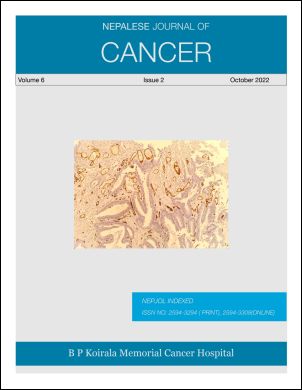Minimally invasive esophagectomy/ gastroesophagectomy for cancer - Long term results from a single institution
DOI:
https://doi.org/10.3126/njc.v6i2.48754Keywords:
Esophageal cancer, Minimal invasive esophagectomy, Esophagectomy, NACTAbstract
Background: Esophagectomy is a complex operation. Minimally invasive esophagectomy (MIE) may decrease the morbidity and mortality of resection. The aim of this study was to produce long term outcome of MIE from a single center in Nepal.
Methods: Patients with squamous cell carcinoma and adenocarcinoma of esophagus/ gastroesophageal junction who underwent MIE between 2001-2018 were analyzed.
Results: 215 patients were taken for MIE during 2001-2018. There was 11.2% conversion rate. Totally MIE approach was performed in 43% cases and hybrid MIE in 57% cases. Mean operative time, intra operative blood loss, anastomotic leak, pulmonary infection, recurrent laryngeal nerve injury and in-hospital mortality were 246 min, 286 ml, 13.1%, 9%, 6.8% and 3%, respectively. Final histopathology revealed most common Stages III and IV in 51.2% and 36.1%, respectively. The median survival was 34 months and 5-OS was 27%. 5-OS was 27% and o% for R0 and R+ resection (p<.001). Median survival after radical and non-radical lymphadenectomy was 36 months and 25 months (p=.003), respectively. Responders to neoadjuvant treatment had the best survival.
Conclusion: MIE has got acceptable post operative morbidities. R0 resection, early stage of disease, radical lymphadenectomy and responders to neoadjuvant treatment had got the best survival results
Downloads
Downloads
Published
How to Cite
Issue
Section
License
Copyright (c) 2022 Nepalese Journal of Cancer

This work is licensed under a Creative Commons Attribution 4.0 International License.
This license lets others distribute, remix, tweak, and build upon your work, even commercially, as long as NJC and the authors are acknowledged.
Submission of the manuscript means that the authors agree to assign exclusive copyright to NJC. The aim of NJC is to increase the visibility and ease of use of open access scientific and scholarly articles thereby promoting their increased usage and impact.




